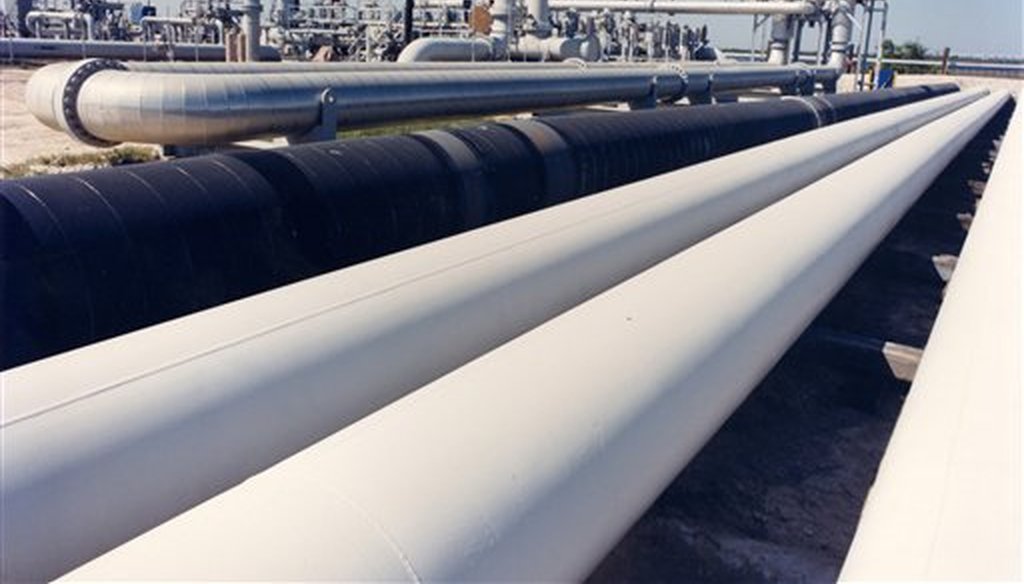Get PolitiFact in your inbox.

Crude oil pipes at the Bryan Mound site near Freeport, Texas, part of the Strategic Petroleum Reserve. (AP/Energy Department).
Donald Trump wrong that Strategic Petroleum Reserve has been ‘mostly empty’ for decades
If Your Time is short
• The Strategic Petroleum Reserve has been entirely full as recently as the early 2010s. For almost a decade before Trump took office, the stockpile was generally 90% full or higher.
• The percentage fell on Trump’s watch.
Facing record-high gas prices and volatile conditions in the international oil market, President Joe Biden announced the largest release from the nation’s oil stockpiles since they were created almost five decades ago.
On March 31, Biden said he would order the release of about 1 million additional barrels from the Strategic Petroleum Reserve every day for six months.
It was unclear whether this would be enough to lower U.S. gasoline prices, especially if other overseas producers lower their production to cancel out the additional oil, thus keeping supply the same and prices high. But Biden’s presidential predecessor, Donald Trump, issued a statement critical of the move.
"So after 50 years of being virtually empty, I built up our oil reserves during my administration, and low energy prices, to 100% full," Trump said. "It’s called the Strategic National Reserves, and it hasn’t been full for many decades. In fact, it’s been mostly empty."
Federal data and energy experts made clear that Trump is wrong on several counts, most notably in the assertion that the stockpile has been "mostly empty" for decades.
"I'm not sure there's anything in that quote that makes any sense at all," said Clark Williams-Derry, an energy finance analyst with the Institute for Energy Economics and Financial Analysis.
Trump’s press office did not respond to an inquiry.
What is the Strategic Petroleum Reserve?
For starters, Trump got the stockpile’s name slightly wrong: It's the Strategic Petroleum Reserve.
The reserve dates from OPEC’s oil embargo in 1973 and 1974, when an oil price shock battered the U.S. economy. It was designed to protect the country from the effects of a severe energy supply interruption, according to the Congressional Research Service.
The reserve has a capacity of more than 700 million barrels, stored in underground geological formations known as salt domes. The reserve encompasses four sites, two each in Louisiana and Texas.
The stockpile’s holdings can be drawn down by about 4.4 million barrels a day. The reserve stores crude oil rather than gasoline, partly because crude oil is more stable. So any oil that’s released must be refined before coming to market.
It takes about two weeks for a new release from the reserve to enter the market. (Once the oil price declines, the U.S. can purchase additional oil to replenish the reserve.)
Biden tried a smaller version of this tactic several months ago. On Nov. 23, 2021, Biden ordered the release of some 50 million barrels of oil from the reserve, or roughly two and a half days of U.S. demand. It was only the fourth time a president had done so. In 1991, President George H.W. Bush released reserves as the Persian Gulf War threatened the international oil market. In 2005, President George W. Bush did it after Hurricane Katrina destroyed oil infrastructure on the Gulf coast. And in 2011, President Barack Obama did it during the civil war in Libya, which prompted concerns about international supply disruptions.
But last November’s release didn’t move gas prices in the U.S. significantly, in part because six weeks later, Russia invaded Ukraine, and as a protest, some Western nations, including the U.S., sought to cut back on buying Russian oil. So in March, prices at the pump in the U.S. began setting new records, setting the stage for Biden’s latest move.
The stockpile is, well, stocked
It’s wrong for Trump to say the stockpile has been "mostly empty" for decades.
Since 1987, about a decade after the Strategic Petroleum Reserve began accepting crude oil, the amount stored has not dropped below 540 million barrels by the end of the calendar year. And most of the time, it was well above that.
Between 2003 and 2020, the level in the stockpile ranged from a low of 634 million barrels to a high of 726 million barrels. While the maximum capacity of the reserve varied somewhat over that period, that represented a big percentage of the stockpile’s maximum capacity.
For instance, in December 2009, the reserve was 100% filled, with 727 million barrels. By the time Trump took office in January 2017, the reserve was in excess of 90% full. The current capacity is slightly lower than its 2009 high; at the end of 2021, the stockpile was roughly 82% full.
Meanwhile, contrary to what Trump said, the stockpile was never completely full while he was in office. Between the end of 2016 and the end of 2020, roughly when Trump was in office, the level of oil in the reserve fell from 695 million barrels to 638 million barrels, a decrease of about 8%. And by the time Trump left office, the stockpile was about 89% full, not 100% full.
The decline on Trump’s watch stemmed from lower-profile reasons, notably sales of crude in the stockpile to capitalize on high oil prices and generate revenue that reduces the federal deficit.
Similar sales were made under Obama. (There was a temporary uptick of 31 million barrels in the stockpile’s level on Trump’s watch between April 2020 and July 2020. That was during the coronavirus pandemic, when demand cratered and prices fell, making additions to the stockpile economical. But this uptick was almost entirely reversed by October 2020.)
Our ruling
Trump said, "It’s called the Strategic National Reserves, and it hasn’t been full for many decades. In fact, it’s been mostly empty."
First, it’s called the "Strategic Petroleum Reserve." Beyond that, the stockpile has been entirely full as recently as the early 2010s, and for almost a decade before Trump took office, the stockpile was generally 90% full or higher. Meanwhile, the percentage filled actually fell on Trump’s watch.
We rate the statement False.
Our Sources
Donald Trump, statement, March 31, 2022
Joe Biden, announcement on the Strategic Petroleum Reserve, March 31, 2022
U.S. Energy Information Administration, "U.S. Ending Stocks of Crude Oil in SPR," accessed March 31, 2022
U.S. Energy Department, "SPR Quick Facts," accessed March 31, 2022
CNN, "Biden announces historic oil reserve release and presses oil companies to do their part to reduce gas prices," March 31, 2022
PolitiFact, "Joe Biden’s release of oil from the Strategic Petroleum Reserve: What you need to know," Nov. 24, 2021
Email interview with Mark Finley, fellow in energy and global oil at Rice University's Baker Institute for Public Policy, March 31, 2022
Email interview with Hugh Daigle, associate engineering professor at the University of Texas-Austin, March 31, 2022
Email interview with Clark Williams-Derry, energy finance analyst with the Institute for Energy Economics and Financial Analysis, March 31, 2022
Browse the Truth-O-Meter
More by Louis Jacobson
Donald Trump wrong that Strategic Petroleum Reserve has been ‘mostly empty’ for decades
Support independent fact-checking.
Become a member!
In a world of wild talk and fake news, help us stand up for the facts.






































